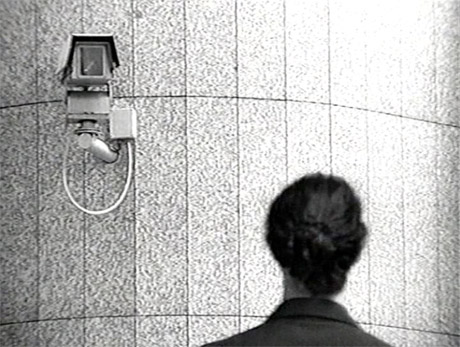Street art group Collective CC installed a clever piece in Lisbon last year: In a variation on the “You are being watched by CCTV”, they have surreptitiously installed “You are being watched by Senioritas” signs below the windows of the city’s ever-vigilant population of old ladies who monitor the neighbourhoods. The signs mimic a local security company’s corporate identity.
The idea relates to the notion that CCTV has evolved to fill a niche left by the redesign of our urban environment. Our cities evolved in a certain way, with streets a particular depth and buildings a particular height, partly to permit this kind of continuous, passive surveillance. The advent of modern technologies, such as steel frame structure, the car, the elevator, the telephone, all disrupt the established order of building cities. In terms of surveillance, this manifests itself in under-observed spaces, and a resultant need for electronic supervision.
I’m reading a paper by Christine Hentschel called “CCTV, “Living Cameras,” and Their Objects in a Post-Apartheid Metropolis”. She discusses another inverted situation: community-based surveillance systems, like the one in Lisbon, used to supplement or completely perform the task of regular CCTV systems in crime-ridden South Africa. Networks of nightclubs and bars, local traders and street hawkers, down to the highly-marginalised car-watchers, are treated as surveillance systems allowing varying degrees of access to either police or criminal organisations.
A further twist to the phenomenon of watching as surveillance is seen in a new company set up in England last year, Internet Eyes. By signing up individuals to watch randomly selected camera feeds (they win a prize if they see a crime), the operation of watching is crowd-sourced to strangers, both spatially and socially seperated from the site of surveillance.
Tuesday, January 11, 2011
Friday, October 1, 2010
Security Camera Mapping: Comparing Belfast and Newcastle

I'm currently rewriting the paper I presented at the Ordnance Conference on War and Architecture in Cork a few weeks ago. Here are some slides for the presentation, along with a link to the raw data from my survey.
Friday, September 24, 2010
London CCTV Cars
Mobile surveillance getting the inverse surveillance treatment in London; via bigbrotherwatch.org.uk
Thursday, September 23, 2010
Surveying CCTV in Public Spaces: a methodology
Short clip on the surveying methodology I used for the paper presented at the Ordnance Conference last week. The results (maps, maps, and some more maps) to follow soon.
Sunday, June 13, 2010
Friday, May 28, 2010
Guardian Commentary of "Exposed: Voyeurism, Surveillance and the Camera" at the Tate

Leah Borromeo's article on the exhibition in the Tate at the moment. Interesting things: she draws attention to the lack of attention paid to the Tate's own in-house surveillance; and the heated debate in the comments, in which she herself gets involved.
above: Denis Beaubois's In The Event of Amnesia the City Will Recall
Thursday, December 10, 2009
The 50 Minute Hour
Interesting piece on surveillance and interrogation. (Click the title to get the video working properly)
Subscribe to:
Posts (Atom)












